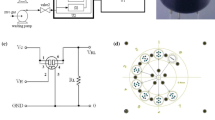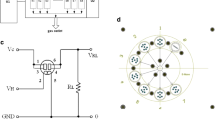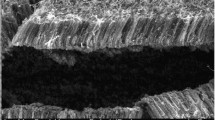Abstract
In this paper, spinyhead croaker (Collichthys lucidus) fat content forecasting model using electronic nose (e-nose) and non-linear stochastic resonance (SR) has been studied. Spinyhead croaker samples are stored at 4 °C temperature. Physical/chemical indexes (firmness, total volatile basic nitrogen (TVB-N), pH, and fat content) are examined to provide quality references for e-nose. E-nose responses are treated by principal component analysis (PCA), bistable SR, and double-layered cascaded serial SR (DCSSR). SR and DCSSR SNR maximal (SNR-Max) values discriminate croakers clearly. Multi-variables regressions (MVR) are conducted between physical/chemical indexes and SR/DCSSR SNR-Max values. MVR results demonstrate that DCSSR feature values have more significant linearity relation with physical/chemical indexes. Spinyhead croaker fat content forecasting model is developed via linear fitting regression on SR SNR-Max values. Validating experimental results demonstrate that the developed model has good accuracy.



Similar content being viewed by others
References
Ameer Q, Adeloju SB (2005) Polypyrrole-based electronic noses for environmental and industrial analysis. Sensors Actuators B Chem 106:541–552
AOAC 991.36 (1996) Fat (crude) in meat and meat products - solvent extraction (submersion) method
Apetrei C, Apetrei IM, Villanueva S, de Saja JA, Gutierrez-Rosales F, Rodriguez-Mendez ML (2010) Combination of an e-nose, an e-tongue and an e-eye for the characterisation of olive oils with different degree of bitterness. Anal Chim Acta 663:91–97
Balasubramanian S, Panigrahi S, Logue CM, Doetkott C, Marchello M, Sherwood JS (2008) Independent component analysis-processed electronic nose data for predicting Salmonella typhimurium populations in contaminated beef. Food Control 19:236–246
Benzi R, Sutera A, Vulpiana A (1981) The mechanism of stochastic resonance. J Phys A 14:L453–L456
Bernabei M, Pennazza G, Santortico M, Corsi C, Roscioni C, Paolesse R, Di Natale C, D’Amico A (2008) A preliminary study on the possibility to diagnose urinary tract cancers by an electronic nose. Sensors Actuators B Chem 131:1–4
Canhoto OF, Magan N (2003) Potential for detection of microorganisms and heavy metals in potable water using electronic nose technology. Biosens Bioelectron 18:751–754
Chanie GE, Westad F, Jonsdottir R, Thalmann CR, Bazzo S, Labreche S, Marcq P, Lundby F, Haugen JE (2005) Prediction of microbial and sensory quality of cold smoked Atlantic salmon (Salmo salar) by electronic nose. J Food Sci 70:563–574
Cheng Y, Wang R, Tianjun X (2011) The mitochondrial genome of the spinyhead croaker Collichthys lucida: genome organization and phylogenetic consideration. Mar Genomics 4(1):17–23
China standard protocols (2003) GB/T 5009.44–2003
Concina I, Falasconi M, Gobbi E, Bianchi F, Musci M, Mattarozzi M, Pardo M, Mangia A, Careri M, Sberveglieri G (2009) Early detection of microbial contamination in processed tomatoes by electronic nose. Food Control 20:873–880
Di Natale C, Macagnano A, Martinelli E, Paolesse R, D’Arcangelo G, Roscioni C, Finazzi-Agro A, D’Amico A (2003) Lung cancer identification by the analysis of breath by means of an array of non-selective gas sensors. Biosens Bioelectron 18:1209–1218
Dutta R, Das A, Stocks NG, Morgan D (2006) Stochastic resonance-based electronic nose: a novel way to classify bacteria. Sensors Actuators B Chem 115:17–27
El Barbri N, Mirhisse J, Ionescu R, El Bari N, Correig X, Bouchikhi B, Llobet E (2009) An electronic nose system based on a micro-machined gas sensor array to assess the freshness of sardines. Sensors Actuators B Chem 141:538–543
Gammaitoni L, Hanggi P, Jung P, Marchesoni F (1998) Stochastic resonance. Rev Mod Phys 70:223–287
Gardner JW, Bartlett P (1999) Electronic noses: principles and applications. Oxford University Press, Oxford
Gomez AH, Wang J, Hu GX, Pereira AG (2007) Discrimination of storage shelf-life for mandarin by electronic nose technique. LWT-Food Sci Technol 40:681–689
Gomez AH, Wang J, Hu GX, Pereira AG (2008) Monitoring storage shelf life of tomato using electronic nose technique. J Food Eng 85:625–631
Hammond J, Marquis B, Michaels R, Oickle B, Segee B, Vetelino J, Bushway A, Camire ME, Dentici KD (2002) A semiconducting metal-oxide array for monitoring fish freshness. Sens Actuators B Chem 84:113–122
Hui G, Wang L, Mo Y, Zhang L (2012) Study of grass carp (Ctenopharygodon idellus) quality predictive model based electronic nose. Sensors Actuators B Chem 166-167:301–308
Hui GH, Wu YL, Ye DD, Ding WW (2013) Fuji apple storage time predictive method using electronic nose. Food Anal Methods 6:82–88
Hui G, Mi S, Chen Q, Chen X (2014) Sweet and bitter tastant discrimination from complex chemical mixtures using taste cell-based sensor. Sensors Actuators B Chem 35:301–308
Lamagna A, Reich S, Rodriguez D, Boselli A, Cicerone D (2008) The use of an electronic nose to characterize emissions from a highly polluted river. Sensors Actuators B Chem 131:121–124
Lerma-Garcia MJ, Simo-Alfonso EF, Bendini A, Cerretani L (2009) Metal oxide semiconductor sensors for monitoring of oxidative status evolution and sensory analysis of virgin olive oils with different phenolic content. Food Chem 117:608–614
Peris M, Escuder-Gilabert L (2009) A 21st century technique for food control: electronic noses. Anal Chim Acta 638:1–15
Ragazzo-Sanchez JA, Chalier R, Chevalier D, Calderon-Santoyo M, Ghommidh C (2008) Identification of different alcoholic beverages by electronic nose coupled to GC. Sensors Actuators B Chem 134:43–48
Reinhard H, Sager F, Zoller O (2008) Citrus juice classification by SPME-GC-MS and electronic nose measurements. LWT-Food Sci Technol 41:1906–1912
Vestergaard JS, Martens M, Turkki P (2007) Application of an electronic nose system for prediction of sensory quality changes of a meat product (pizza topping) during storage. Lwt-Food Science and Technology 40:1095–1101
Wang B, Xu SY, Sun DW (2010) Application of the electronic nose to the identification of different milk flavorings. Food Res Int 43:255–262
Zhang HM, Wang J (2007) Detection of age and insect damage incurred by wheat, with an electronic nose. J Stored Prod Res 43:489–495
Zhang HM, Chang MX, Wang J, Ye S (2008) Evaluation of peach quality indices using an electronic nose by MLR, QPST and BP network. Sensors Actuators B Chem 134:332–338
Zheng H, Wang J (2006) Electronic nose and data analysis for detection of maize oil adulteration in sesame oil. Sensors Actuators B Chem 119(2):449–455
Zhu LM, Seburg RA, Tsai E, Puech S, Mifsud JC (2004) Flavor analysis in a pharmaceutical oral solution formulation using an electronic-nose. J Pharm Biomed Anal 34:453–461
Funding
This work is financially supported by Scientific Research Project of National Natural Science Foundation of China (No. U1709212), Scientific Research Project of Zhejiang Province (Grant No. 2019C02075, LGG18F030006, LGG19F010012, LY19F030023), China College Student Research Programme (105–2013200055), and College Student Research Programme of Zhejiang Province.
Author information
Authors and Affiliations
Corresponding author
Ethics declarations
Conflict of Interest
Author Haonan Zheng has received research grant from Scientific Research Project of Zhejiang Province (No. LGG19F010012). Author Jian Li has received research grant from Scientific Research Project of Zhejiang Province (No. LGG18F030006). Author Xiongwei Lou has received research grant from Scientific Research Project of Zhejiang Province (No. LGG18F030006). Author Xiaomei Yi has received research grant from Scientific Research Project of Zhejiang Province (No. LGG19F010012). Author Guohua Hui has received research grant from Scientific Research Project of National Natural Science Foundation of China (No. U1709212). Haonan Zheng declares that he has no conflict of interest. Siyang Wang declares that she has no conflict of interest. Xinyi Ping declares that she has no conflict of interest. Chenning Shao declares that she has no conflict of interest. Huimin Zhou declares that she has no conflict of interest. Bin Xiang declares that he has no conflict of interest. Jian Li declares that he has no conflict of interest. Xiongwei Lou declares that he has no conflict of interest. Xiaomei Yi declares that she has no conflict of interest. Guohua Hui declares that he has no conflict of interest.
Ethical Approval
All applicable international, national, and/or institutional guidelines for the care and use of animals were followed.
Informed Consent
Not applicable.
Additional information
Publisher’s Note
Springer Nature remains neutral with regard to jurisdictional claims in published maps and institutional affiliations.
Rights and permissions
About this article
Cite this article
Zheng, H., Wang, S., Ping, X. et al. Study of Spinyhead Croaker (Collichthys lucidus) Fat Content Forecasting Model Based on Electronic Nose and Non-linear Data Resolution Model. Food Anal. Methods 12, 1927–1937 (2019). https://doi.org/10.1007/s12161-019-01510-x
Received:
Accepted:
Published:
Issue Date:
DOI: https://doi.org/10.1007/s12161-019-01510-x




